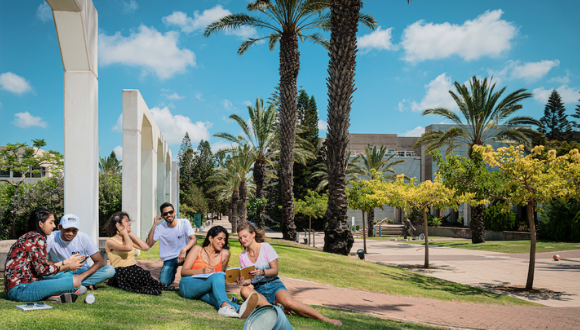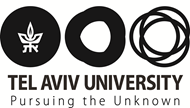Award Winning Campus
Our campus is more than a place of learning and research – it's an entire universe – both in the academic sense of the word and in terms of the affinity between the physical campus and its intellectual activity.
Named as Israel's most beautiful university campus in 2004 by the Council for a Beautiful Israel, Tel Aviv University's 200 acre campus is a unique open-air museum of modern architecture and plastic arts spanning the past five decades. The campus achieves a balance between beauty and function among its buildings, landscaping, environmental design and sculptures, many by renowned Israeli and international architects and artists. The use of sculpture as a key element in campus landscaping has been a guiding principle of TAU's Campus Art Committee throughout the years.
From the minimalist International style of early Tel Aviv, to the concrete Brutalist style of the 1970s and onward, to the Post- and Neo-Modernism of more recent times, the TAU campus reflects the wide range of contemporary building styles all integrated into a harmonious setting designed by Dan Zur and L. Yahalom.
Campus Highlights

The Wolfson Building for Mechanical Engineering, designed by celebrated American architect Louis L. Kahn, in the concrete Brutalist style and completed in 1980, is a site of pilgrimage for architecture enthusiasts from around the world.

The Roman Abramovich Building for Nano and Quantum Science, inaugurated in 2024, is an architectural and scientific marvel not only for our campus and Israel but for the entire world. The Abramovich Building marks a new era in nanotechnology: its ground floor houses Israel's largest clean room, where nanomaterials and cutting-edge nanotechnologies are developed. There is also a 1650 square meter basement housing an advanced sub-fab facility meeting stringent vibration standards for its electron microscopes.

At the heart of the TAU campus stands the Check Point Building, an architectural marvel inspired by cloud computing and the relationship between the physical and the virtual. This cutting-edge facility boasts state-of-the-art amenities designed to foster innovation and collaboration, and houses the Blavatnik School of Computer Science.

The Porter School of Environmental Studies is housed in the Capsule Building—a LEED Platinum building that creates its own electricity using solar energy and has a rooftop garden that treats and recycles water. The Capsule Building received the first place (in the public buildings category) at the Israeli Association of Builders' Excellence Awards in 2014.

The asymmetrical and decorative adornment of the Jack Green Building of Biotechnology (1991) by Moshe Tsur expresses Post-modernism's use of classical and contemporary architectural elements.

The George S. Wise Senate Building, designed by Yuval Cadmon, is a prime example of the Neo-Modernist synthesis of classical and contemporary stylistic elements. It features a sphere, by Italian artist Arnaldo Pomodoro (1984), one of the major works of art on campus. Reminiscent of a globe, the bronze sculpture symbolizes the universality of the human endeavor of learning.

The monumental Sourasky Central Library building dominates the Schreiber Square, the central square of the campus. Completed in 1968, the building was designed by Shulamit Nadler and Moshe Gil and won the Municipality of Tel Aviv-Jaffa's Rokach Prize in 1970. It was commemorated on a stamp issued by the postal authority in 1974. The design achieves a delicate balance between all the elements of the structure. This is expressed in the relationship between the ground floor and the main library area which seems suspended in midair above it.

One of Israel's most unique works of architecture and interior design is the Cymbalista Jewish Heritage Center designed by Swiss architect Mario Botta. The Center's conspicuous twin towers, one of which houses a synagogue and the other an auditorium, reflect the secular and religious streams in Israeli society and the attempt to bridge between them.

The Levi and Fortuna Ezkenazi Sculpture Garden, situated adjacent to the Genia Schreiber University Art Gallery at the main entrance to the University, comprises a collection of 30 outdoor sculptures donated by Italy's Giulia and Beniamino Matatia in memory of their parents, including the important works, The Wings of Peace by Carlo Zauli and Solar Stairs: Homage to Kepler by Giò Pomodoro.

Located in the campus's central Jacob and Shoshana Schreiber Square, the monument Kesher ("Connection"), created by world-renowned designer and TAU Honorary Doctor Ron Arad and donated by Michel Benabou and the French Friends of TAU, commemorates Ethiopian Jews who perished on their way from Ethiopia to Israel.

Depicting a bronze figure rising out of the ruins of the Holocaust, TAU supporter Varda Yoran's Shoah and Revival is situated in front of the engineering complex.

On a similar theme but fashioned out of travertine stone, is Holocaust and Heroism (1990-91), by Emmanuel Hatzofe. Fittingly located in the Holocaust and Heroism Square in front of the Gruss Building, it is a gift of David and Fela Shapell, USA. The two parts of the monumental sculpture recall a mother protecting her child.


